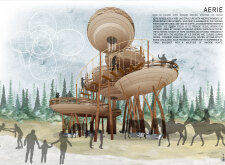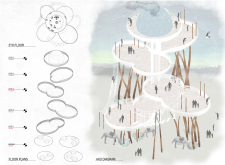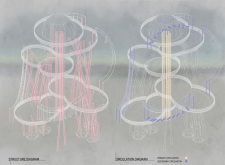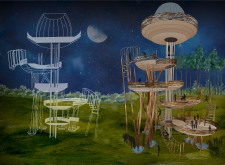5 key facts about this project
The architecture of Aerie is characterized by its tiered circular platforms that resemble a tree canopy. Each level is crafted to offer panoramic views of the biosphere, emphasizing the connection between the structure and its environment. The design integrates ramps and staircases to promote accessibility and seamless movement throughout the space, catering to users of all ages.
Unique Approach to Design
Aerie distinguishes itself through its organic form and material selection, contributing to both aesthetic and functional elements of the project. The use of wood for flooring and structural supports enhances warmth, while glass elements increase visibility and light penetration. Steel is employed where necessary for structural reinforcement, allowing for slender profiles that maintain the project’s lightweight appearance.
A key design strategy is the integration of seasonal activities. The facility supports rope courses and ice skating, allowing for diverse recreational opportunities year-round. This multifunctional use is a direct response to the site's ecological context, fostering a relationship between visitors and the surrounding environment.
Details of Architectural Composition
The overall structure comprises five distinct tiers, each providing unique vantage points. The circular forms not only facilitate social interaction but also create a cohesive flow between different levels. Each platform serves as a gathering space, inviting users to engage with one another while enjoying the natural setting.
Additionally, the design considers sustainability by maximizing the structure's harmony with the natural landscape. The architectural manifestation reflects a commitment to ecological sensitivity, reinforcing the importance of conservation and community connectivity.
For further insights into the architectural plans, sections, and overall design concepts of Aerie, we encourage a detailed exploration of the project presentation. Understanding the architectural ideas and design choices in depth offers a comprehensive view of the project’s role within both the immediate and broader ecological context.


























